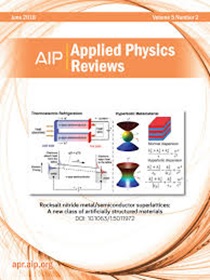Nanofibrous scaffolds for bone and cartilage regeneration
IF 11.6
1区 物理与天体物理
Q1 PHYSICS, APPLIED
引用次数: 0
Abstract
Bone, cartilage, and their composites in various joints are the most important components that form the skeletal structure and enable motion and movements of the body. Their disease and/or loss are most debilitating and afflict millions of Americans, reducing productivity and deteriorating quality of life. Due to limited treatments, scientists, engineers, and clinical doctors are investigating new tissue engineering solutions. In tissue engineering approaches, scaffolds are artificially designed temporary matrices that accommodate stem/progenitor cells and provide both physical and biological signals to guide cell differentiation and 3D tissue regeneration but eventually degrade and leave behind regenerated functional tissues or organs. Therefore, scaffolds often substantially benefit from mimicking certain features of the natural extracellular matrix (ECM) and designing certain engineered features to facilitate cell repopulation, mass transportation, and mechanical and biological cues for cells to regenerate tissue. This review article focuses on the design, synthesis, fabrication, and functionalization of nanofibrous materials to mimic the ECM, deliver biological signals, and integrate various engineering design features such as pore shape, size, connectivity, tissue architectures, and anatomic tissue/organ shapes to guide 3D tissue regeneration. In addition to biological and physical principles of scaffold design and fabrication, we also provide several examples of specific applications of these advanced nanofibrous scaffolds for bone, cartilage, and their associated composite tissue regeneration in osteochondral defects. We also discuss the interdisciplinary and multidisciplinary nature of these research directions, the importance of collaborations across disciplines, and the perspectives of future developments in the field.纳米纤维支架用于骨和软骨再生
骨、软骨及其在各种关节中的复合材料是形成骨骼结构和使身体运动的最重要的组成部分。他们的疾病和/或丧失是最令人衰弱的,折磨着数百万美国人,降低了生产力,恶化了生活质量。由于治疗方法有限,科学家、工程师和临床医生正在研究新的组织工程解决方案。在组织工程方法中,支架是人工设计的临时基质,可以容纳干细胞/祖细胞,并提供物理和生物信号来指导细胞分化和3D组织再生,但最终会降解并留下再生的功能组织或器官。因此,支架通常从模仿天然细胞外基质(ECM)的某些特征和设计某些工程特征中获益,以促进细胞再生、大量运输以及细胞再生组织的机械和生物线索。本文综述了纳米纤维材料的设计、合成、制造和功能化,以模拟ECM,传递生物信号,并整合各种工程设计特征,如孔隙形状、大小、连通性、组织结构和解剖组织/器官形状,以指导3D组织再生。除了支架设计和制造的生物学和物理原理外,我们还提供了这些先进的纳米纤维支架在骨、软骨及其相关复合组织再生骨软骨缺损中的具体应用的几个例子。我们还讨论了这些研究方向的跨学科和多学科性质,跨学科合作的重要性,以及该领域未来发展的前景。
本文章由计算机程序翻译,如有差异,请以英文原文为准。
求助全文
约1分钟内获得全文
求助全文
来源期刊

Applied physics reviews
PHYSICS, APPLIED-
CiteScore
22.50
自引率
2.00%
发文量
113
审稿时长
2 months
期刊介绍:
Applied Physics Reviews (APR) is a journal featuring articles on critical topics in experimental or theoretical research in applied physics and applications of physics to other scientific and engineering branches. The publication includes two main types of articles:
Original Research: These articles report on high-quality, novel research studies that are of significant interest to the applied physics community.
Reviews: Review articles in APR can either be authoritative and comprehensive assessments of established areas of applied physics or short, timely reviews of recent advances in established fields or emerging areas of applied physics.
 求助内容:
求助内容: 应助结果提醒方式:
应助结果提醒方式:


